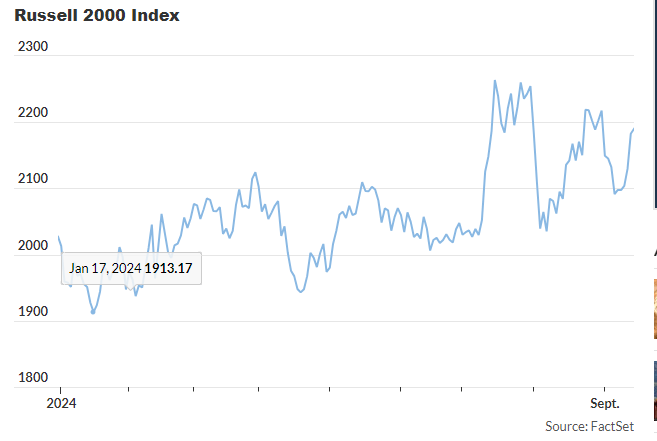Small-Cap Stocks: Ready to Soar After Fed Rate Cut?
Small-cap stocks are navigating a fog of uncertainty surrounding the U.S. economy and Federal Reserve policy, analysts say.
Despite a strong rally over the past month, where the Russell 2000 Index (RUT) climbed 3%, outpacing the S&P 500’s 1.4% gain, questions remain about the sustainability of this momentum. Investors are grappling with concerns over the broader economic outlook and the Fed’s upcoming decisions on interest rates.
After an impressive 13% surge in July, the Russell 2000 has been on a volatile path, retreating nearly half of those gains in August. Market experts, however, suggest that the bullish momentum in small-cap stocks could persist, driven by the potential for rate cuts and hopes for a “soft landing” for the U.S. economy—where growth slows but avoids recession.
Why Rate Cuts Matter for Small Caps
Smaller companies often benefit more from rate cuts than larger ones due to their higher debt levels and reliance on external financing. With the Federal Reserve expected to start reducing rates, many market participants are optimistic about small caps continuing to outperform the broader market. Furthermore, small-cap valuations appear attractive. For example, the S&P SmallCap 600’s forward price-to-earnings ratio is 16.7, compared to 23.4 for the S&P 500.
Analysts expect earnings for small caps to grow at a faster pace, with forecasts of a 20% rise by 2025, versus around 15% for large caps, according to FactSet. “The Fed’s rate cuts could be a key catalyst for renewed interest in small-cap stocks,” said Matt Palazzolo, senior investment analyst at Bernstein Private Wealth Management.
Impact of the Size of Rate Cuts
While the Fed is expected to ease monetary policy, the size of the rate cut remains uncertain. Traders are split between expecting a 25 or 50 basis point reduction. A larger cut could support small-cap stocks further, though some worry it might signal a sharper-than-expected economic slowdown, potentially impacting corporate earnings.
Jordan Irving, portfolio manager at Glenmede Investment Management, highlighted that sustained earnings growth for small caps is still needed for the rally to have long-term traction. However, Palazzolo noted that the magnitude of the cut is less important for small-cap performance in the long run, advising investors not to get too caught up in the near-term debate.

‘Value Versus Growth’ in Small-Cap Stocks
The recent outperformance of small caps is also seen as part of the “value versus growth” trend. Sectors like financials and real estate, which are heavily represented in small-cap indices, have been key contributors to this rally. In the past three months, the S&P SmallCap 600’s financials sector rose 21.6%, while real estate advanced 18.1%. These sectors also outperformed within the large-cap S&P 500.
This trend reflects broader shifts in the market, as large-cap tech stocks have faced headwinds, while value-oriented and income-generating sectors have gained favor.




